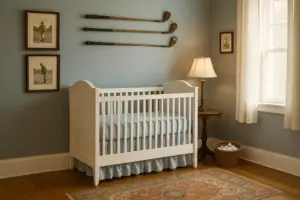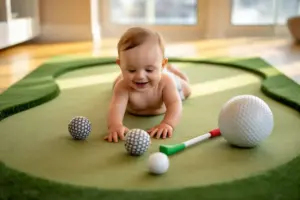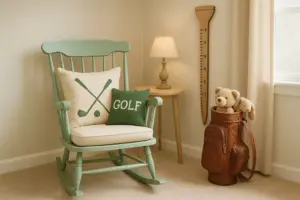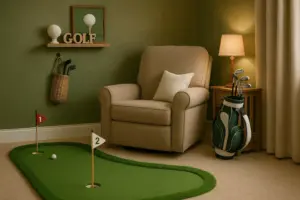How to Choose Golf Nursery Baby Boy Paint Colors for a Calm & Classic Look
Picture this: You’re standing in the paint aisle, overwhelmed by hundreds of color swatches, trying to create the perfect golf-themed nursery for your baby boy. The wrong color choice could turn your peaceful sanctuary into a chaotic space that disrupts sleep and overwhelms your little one. Choosing the right paint colors for a golf nursery isn’t just about aesthetics—it’s about creating a calming environment that promotes healthy development while celebrating your passion for the game.
Creating a golf-themed nursery that feels both sophisticated and soothing requires careful consideration of color psychology, lighting, and design balance. The key lies in selecting hues that capture the essence of the golf course while maintaining the tranquil atmosphere essential for a baby’s room.
Key Takeaways

- Soft greens and muted earth tones create the perfect foundation for a golf nursery while promoting calm and relaxation
- The 60-30-10 color rule ensures balanced design: 60% neutral base, 30% golf-inspired accent color, 10% bold highlights
- Natural lighting significantly impacts how paint colors appear throughout the day, making testing essential
- Combining multiple shades of the same color family creates depth without overwhelming the space
- Classic color combinations like sage green with cream or soft blue with beige offer timeless appeal that grows with your child
Understanding Color Psychology in Baby Nurseries
The Science Behind Calming Colors
Color psychology plays a crucial role in creating environments that support healthy infant development. Soft, muted tones have been scientifically proven to reduce stress hormones and promote better sleep patterns in babies. When designing a golf nursery, this principle becomes even more important as you balance thematic elements with developmental needs.
Research from pediatric sleep specialists indicates that cool and neutral colors help regulate circadian rhythms, making them ideal choices for nursery walls. These colors create a sense of security and comfort that’s essential during those early months when establishing healthy sleep routines.
Golf Course Inspiration for Nursery Colors
The natural beauty of golf courses provides an excellent color palette for nurseries. Think beyond the obvious bright green and consider:
- Morning mist grays that capture early tee times
- Soft sand beiges reminiscent of bunkers and fairways
- Sky blues that reflect peaceful golf course horizons
- Sage greens that mirror the subtle variations in grass and foliage
These colors naturally create the calm, classic look you’re seeking while maintaining a clear connection to golf.
Essential Golf Nursery Color Foundations
Primary Base Colors
Sage Green: The Perfect Golf Green
Sage green stands out as the ideal base color for golf nurseries. Unlike bright emerald or forest green, sage offers:
- Calming properties that promote sleep
- Natural earth tone qualities
- Versatility with both warm and cool accent colors
- Gender-neutral appeal that grows with your child
Soft Cream and Warm White
Cream and warm white serve as excellent neutral foundations that:
- Maximize natural light reflection
- Create a clean, classic appearance
- Pair beautifully with any golf-inspired accent colors
- Provide a timeless backdrop for changing décor
Gentle Gray Tones
Light gray shades offer sophisticated alternatives that:
- Evoke morning mist on golf courses
- Work well in rooms with limited natural light
- Complement both warm and cool color schemes
- Create a modern, upscale nursery aesthetic
Secondary Accent Colors
Navy Blue for Classic Appeal
Navy blue adds depth and sophistication while:
- Referencing traditional golf attire
- Providing excellent contrast with lighter base colors
- Creating a timeless, preppy aesthetic
- Working well with metallic accents
Warm Taupe and Mushroom
Earth-toned neutrals like taupe and mushroom:
- Ground the color scheme in natural elements
- Add warmth without overwhelming the space
- Complement golf course-inspired artwork and accessories
- Create cozy, inviting atmospheres
The 60-30-10 Color Rule for Golf Nurseries
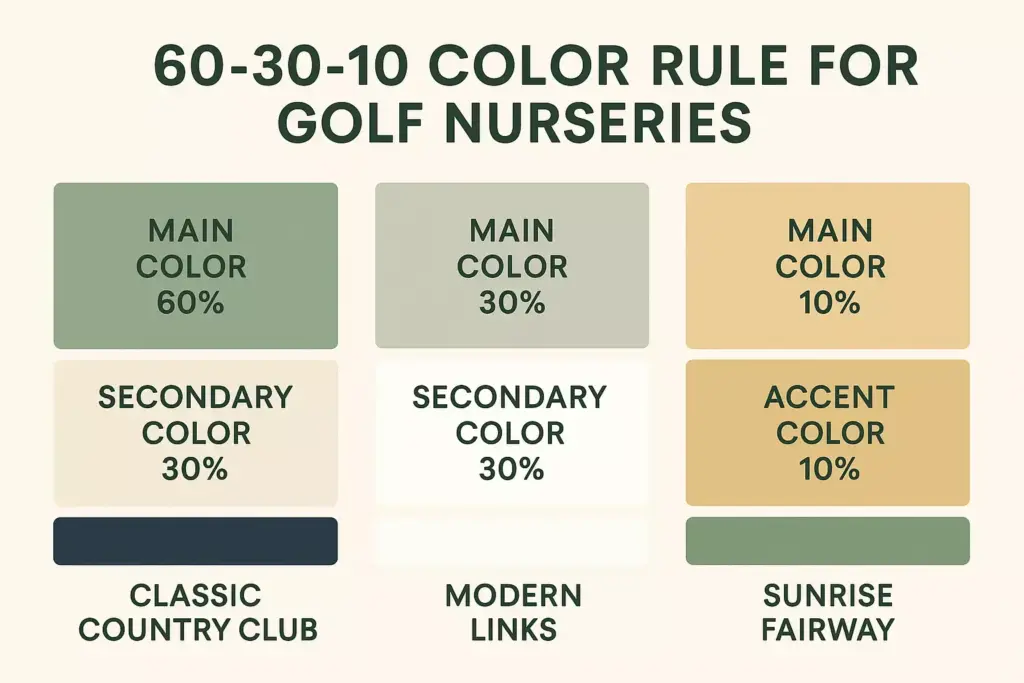
Understanding the Formula
The 60-30-10 rule is a professional interior design principle that ensures balanced, harmonious color schemes:
- 60% Dominant Color: Your main wall color (typically a soft neutral)
- 30% Secondary Color: Accent walls, larger furniture pieces, or major décor elements
- 10% Accent Color: Small accessories, artwork, and highlight pieces
Applying the Rule to Golf Themes
Example Combination 1:
- 60%: Soft sage green walls
- 30%: Cream furniture and window treatments
- 10%: Navy blue accessories and artwork
Example Combination 2:
- 60%: Warm cream walls
- 30%: Soft gray furniture and rugs
- 10%: Muted green golf-themed accents
This approach ensures your golf nursery feels cohesive rather than overwhelming or chaotic.
Top Golf-Inspired Color Combinations
Classic Country Club Palette
Primary Colors: Sage green, cream, navy blue
Why It Works: This combination captures the timeless elegance of traditional golf clubs while maintaining the calm atmosphere essential for nurseries.
Implementation Tips:
- Use sage green on three walls
- Create an accent wall in cream behind the crib
- Add navy blue through bedding, curtains, and accessories
Modern Links Palette
Primary Colors: Soft gray, warm white, muted green
Why It Works: This contemporary approach feels fresh and sophisticated while still honoring golf traditions.
Implementation Tips:
- Paint all walls in soft gray
- Use warm white for trim and ceiling
- Incorporate muted green through artwork and textiles
Sunrise Fairway Palette
Primary Colors: Warm beige, soft gold, sage green
Why It Works: This combination evokes the peaceful beauty of early morning golf rounds while creating a cozy, nurturing environment.
Implementation Tips:
- Use warm beige as the dominant wall color
- Add soft gold through lighting and metallic accents
- Include sage green in furniture and larger décor pieces
Testing Paint Colors in Your Nursery
The Importance of Natural Light
Natural lighting dramatically affects how paint colors appear throughout the day. Colors that look perfect in the store may appear completely different in your nursery’s specific lighting conditions.
Proper Testing Techniques
- Purchase sample sizes of your top 3-5 color choices
- Paint large swatches (at least 2×2 feet) on different walls
- Observe colors at various times: morning, afternoon, and evening
- Consider artificial lighting impact during nighttime feedings
- Live with samples for at least 3-4 days before deciding
Common Lighting Challenges
- North-facing rooms tend to make colors appear cooler and grayer
- South-facing rooms can intensify warm tones and make colors appear brighter
- East-facing rooms get beautiful morning light but may feel cooler in afternoons
- West-facing rooms can become quite warm and bright in late afternoon
Paint Finish Selection for Nursery Walls

Recommended Finishes
Eggshell Finish
Best overall choice for nursery walls because it:
- Provides subtle sheen that’s easy to clean
- Hides minor wall imperfections
- Resists moisture and stains
- Offers durability for long-term use
Satin Finish
Good alternative that offers:
- Higher durability and easier cleaning
- Slight sheen that reflects light nicely
- Better resistance to scuffs and marks
- Ideal for high-traffic areas
Finishes to Avoid
- Flat/Matte: Difficult to clean and shows every mark
- Semi-gloss: Too shiny and can be overwhelming in large spaces
- Gloss: Far too reflective and institutional-looking for nurseries
Creating Depth with Multiple Shades
Monochromatic Schemes
Using multiple shades of the same color creates sophisticated depth while maintaining calm:
Sage Green Variations:
- Lightest shade: Upper walls and ceiling
- Medium shade: Lower walls or wainscoting
- Darkest shade: Accent wall behind crib
Tonal Layering Techniques
- Start with your lightest shade as the base
- Add medium tones through furniture and larger accessories
- Include darker accents sparingly for visual interest
- Use white or cream to break up color and add brightness
Incorporating Golf Elements Without Overwhelming
Subtle Golf References
Instead of obvious golf motifs, consider:
- Landscape artwork featuring golf courses
- Vintage golf photography in muted tones
- Abstract art in golf course colors
- Textural elements like grass cloth wallpaper accents
Balancing Theme and Tranquility
The key to a successful golf nursery lies in suggestion rather than declaration. Your color choices should whisper “golf” rather than shout it.
Effective Strategies:
- Keep bold golf elements to 10% of the overall design
- Choose artwork that could work in any sophisticated space
- Focus on the natural beauty of golf courses rather than equipment
- Use texture and pattern to reference golf without being literal
Budget-Friendly Color Implementation
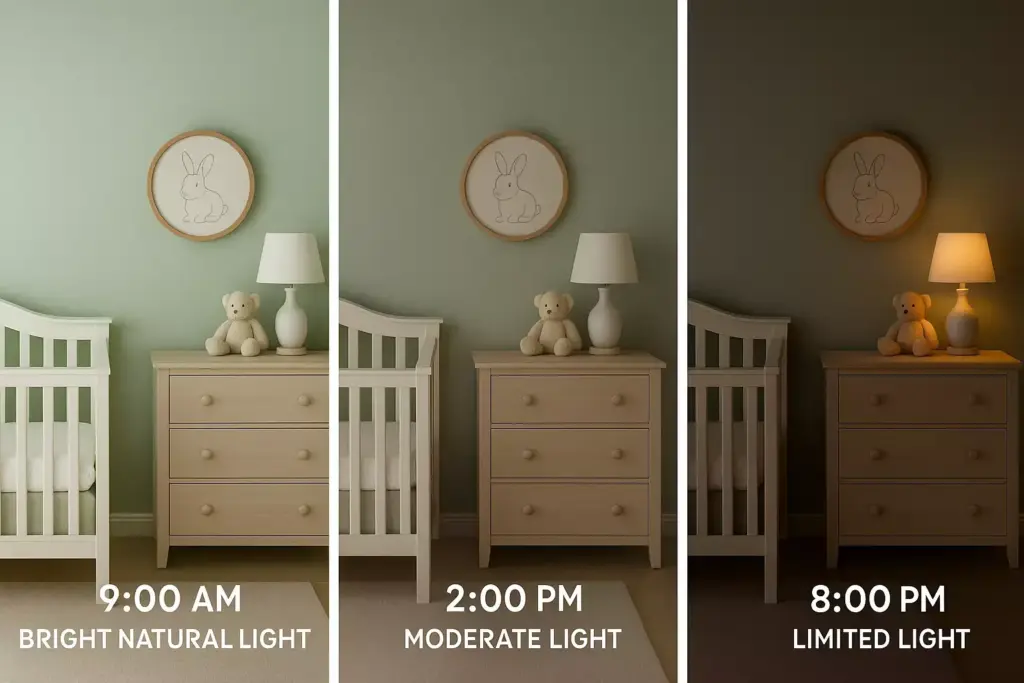
High-Impact, Low-Cost Changes
Accent Walls: Create dramatic impact with minimal paint
- Choose one wall for your secondary color
- Use painter’s tape for clean, professional lines
- Consider geometric patterns for modern appeal
DIY Techniques:
- Color washing creates subtle texture and depth
- Sponge painting adds organic, natural-looking variation
- Ombre effects can mimic sky or grass gradations
Prioritizing Your Paint Budget
- Invest in quality paint for main wall colors
- Use premium primer for better coverage and durability
- Consider accent walls instead of painting entire rooms in expensive colors
- Save on ceiling paint by using standard white in eggshell finish
Seasonal Considerations for Golf Nursery Colors
Year-Round Appeal
Choose colors that feel appropriate regardless of season:
Spring/Summer Friendly:
- Sage green with cream
- Soft gray with white
- Warm beige with muted green
Fall/Winter Cozy:
- Add warm lighting to cool color schemes
- Include textiles in warmer tones
- Use wood accents to add warmth
Adapting with Accessories
Your base paint colors should remain constant, but you can easily adapt the feeling of the room through:
- Seasonal bedding and curtains
- Changing artwork and wall décor
- Adjusting lighting warmth and intensity
- Adding or removing textural elements
🏌️ Golf Nursery Color Palette Selector
Common Mistakes to Avoid
Color Selection Errors
Choosing Colors Too Bold: Bright, saturated colors may seem fun but can be overstimulating for babies and may quickly go out of style.
Ignoring Lighting Conditions: Failing to test colors in your specific room’s lighting can lead to disappointment and costly repainting.
Overwhelming with Theme: Making every element golf-related creates a chaotic environment rather than a peaceful nursery.
Application Mistakes
Skipping Primer: Quality primer ensures true color representation and better paint adhesion.
Poor Paint Quality: Cheap paint often requires multiple coats and doesn’t provide the smooth, durable finish needed in nurseries.
Inadequate Preparation: Rushing the prep work leads to uneven coverage and unprofessional results.
Maintenance and Longevity
Choosing Durable Paint
High-Quality Paints offer several advantages for nurseries:
- Better stain resistance for inevitable spills and marks
- Easier cleaning without color fading
- Longer-lasting color that won’t need frequent touch-ups
- Better coverage that may require fewer coats
Planning for Growth
Consider how your color choices will work as your child grows:
Toddler Years (2-4):
- Colors should hide fingerprints and small marks
- Washable finishes become even more important
- Theme flexibility allows for easy décor updates
School Age (5-8):
- Classic color choices provide a sophisticated backdrop for changing interests
- Neutral bases allow for easy accent color changes
- Quality paint ensures the room still looks fresh
Professional vs. DIY Considerations
When to Hire Professionals
Consider professional painters for:
- Complex color schemes with multiple accent walls
- Detailed trim work that requires precision
- Time constraints with a baby on the way
- Specialty finishes like color washing or texturing
DIY Success Tips
If painting yourself:
- Invest in quality tools: Good brushes and rollers make a significant difference
- Take your time: Rushing leads to mistakes and poor results
- Prepare thoroughly: Clean walls, fill holes, and use proper primer
- Work in good lighting: Natural light helps you see true colors and coverage
- Plan for multiple coats: Most colors require at least two coats for even coverage
Conclusion
Creating the perfect golf nursery with calm and classic paint colors requires thoughtful planning and attention to detail. The key lies in balancing your love of golf with the peaceful environment your baby needs to thrive. By choosing soft, muted colors inspired by the natural beauty of golf courses, you can create a space that feels both sophisticated and nurturing.
Remember these essential principles: test colors thoroughly in your specific lighting conditions, follow the 60-30-10 rule for balanced color distribution, and prioritize quality paint and proper application techniques. The color choices you make today will serve as the foundation for years of peaceful nights and happy memories.
Your next steps should include:
- Measure your nursery and note lighting conditions throughout the day
- Purchase sample paints for your top color choices and test them for several days
- Plan your color distribution using the 60-30-10 rule
- Gather quality painting supplies or research professional painters in your area
- Create a timeline that allows for proper preparation, painting, and drying before baby’s arrival
With careful planning and the right color choices, your golf nursery will become a timeless space that celebrates your passion while providing the calm, classic environment perfect for your little one’s early years. The investment in quality colors and proper application will pay dividends in both the room’s appearance and your family’s enjoyment of this special space.



